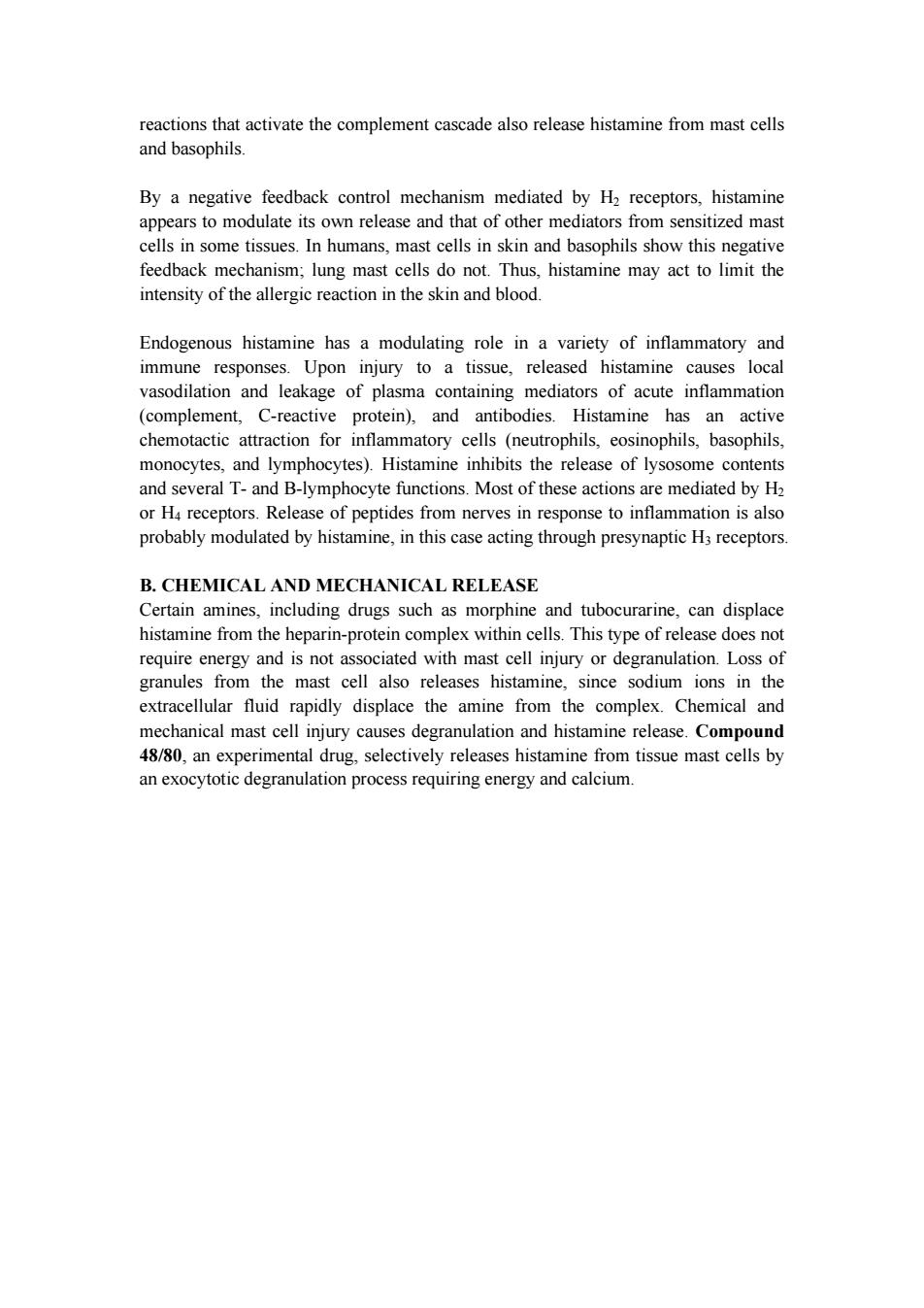正在加载图片...

reactions that activate the complement cascade also release histamine from mast cells and basophils. By a negative feedback control mechanism mediated by H2 receptors,histamine appears to modulate its own release and that of other mediators from sensitized mast cells in some tissues.In humans,mast cells in skin and basophils show this negative feedback mechanism;lung mast cells do not.Thus,histamine may act to limit the intensity of the allergic reaction in the skin and blood. Endogenous histamine has a modulating role in a variety of inflammatory and immune responses.Upon injury to a tissue,released histamine causes local vasodilation and leakage of plasma containing mediators of acute inflammation (complement,C-reactive protein),and antibodies.Histamine has an active chemotactic attraction for inflammatory cells (neutrophils,eosinophils,basophils, monocytes,and lymphocytes).Histamine inhibits the release of lysosome contents and several T-and B-lymphocyte functions.Most of these actions are mediated by H2 or H4 receptors.Release of peptides from nerves in response to inflammation is also probably modulated by histamine,in this case acting through presynaptic H3 receptors. B.CHEMICAL AND MECHANICAL RELEASE Certain amines,including drugs such as morphine and tubocurarine,can displace histamine from the heparin-protein complex within cells.This type of release does not require energy and is not associated with mast cell injury or degranulation.Loss of granules from the mast cell also releases histamine,since sodium ions in the extracellular fluid rapidly displace the amine from the complex.Chemical and mechanical mast cell injury causes degranulation and histamine release.Compound 48/80,an experimental drug,selectively releases histamine from tissue mast cells by an exocytotic degranulation process requiring energy and calcium.reactions that activate the complement cascade also release histamine from mast cells and basophils. By a negative feedback control mechanism mediated by H2 receptors, histamine appears to modulate its own release and that of other mediators from sensitized mast cells in some tissues. In humans, mast cells in skin and basophils show this negative feedback mechanism; lung mast cells do not. Thus, histamine may act to limit the intensity of the allergic reaction in the skin and blood. Endogenous histamine has a modulating role in a variety of inflammatory and immune responses. Upon injury to a tissue, released histamine causes local vasodilation and leakage of plasma containing mediators of acute inflammation (complement, C-reactive protein), and antibodies. Histamine has an active chemotactic attraction for inflammatory cells (neutrophils, eosinophils, basophils, monocytes, and lymphocytes). Histamine inhibits the release of lysosome contents and several T- and B-lymphocyte functions. Most of these actions are mediated by H2 or H4 receptors. Release of peptides from nerves in response to inflammation is also probably modulated by histamine, in this case acting through presynaptic H3 receptors. B. CHEMICAL AND MECHANICAL RELEASE Certain amines, including drugs such as morphine and tubocurarine, can displace histamine from the heparin-protein complex within cells. This type of release does not require energy and is not associated with mast cell injury or degranulation. Loss of granules from the mast cell also releases histamine, since sodium ions in the extracellular fluid rapidly displace the amine from the complex. Chemical and mechanical mast cell injury causes degranulation and histamine release. Compound 48/80, an experimental drug, selectively releases histamine from tissue mast cells by an exocytotic degranulation process requiring energy and calcium